 In this German folktale (also known as The Magic Porridge Pot), a kind old woman gives a magic pot to a poor girl looking for something to eat in a forest. When someone says special words, the pot cooks sweet porridge. The only problem for the girl, her mother and the village they live in is that you need to say special words to make the pot stop cooking. This is a popular teaching story for 3-5 year-olds, made more so because the poem that inspired it was also the source for a famous Disney film segment. More…
In this German folktale (also known as The Magic Porridge Pot), a kind old woman gives a magic pot to a poor girl looking for something to eat in a forest. When someone says special words, the pot cooks sweet porridge. The only problem for the girl, her mother and the village they live in is that you need to say special words to make the pot stop cooking. This is a popular teaching story for 3-5 year-olds, made more so because the poem that inspired it was also the source for a famous Disney film segment. More…
Archives
Fairy Ointment
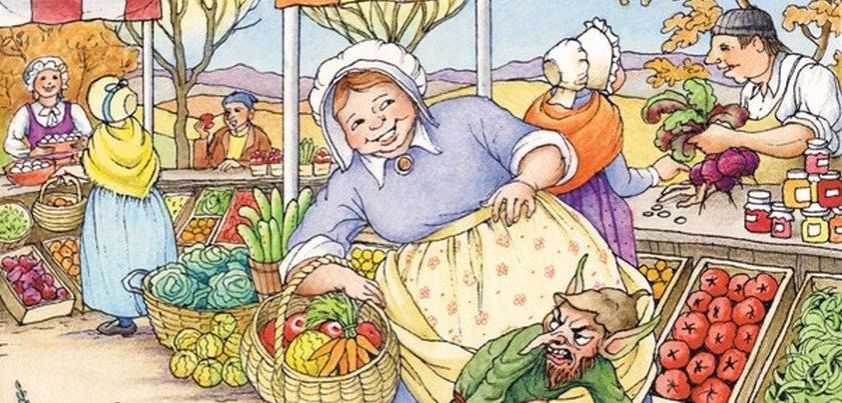 In this folktale, a strange looking little old man asks a nurse to come to his house to help his sick wife look after their baby boy. The man’s wife gives the nurse some ointment to put on the baby’s eyes. Being curious, the nurse puts some of it on one of her own eyes. The family seemed normal enough up to this point. However, the ointment helps her to learn their secret. The nurse pays a heavy price for her actions when the old man finds out what she has done. More…
In this folktale, a strange looking little old man asks a nurse to come to his house to help his sick wife look after their baby boy. The man’s wife gives the nurse some ointment to put on the baby’s eyes. Being curious, the nurse puts some of it on one of her own eyes. The family seemed normal enough up to this point. However, the ointment helps her to learn their secret. The nurse pays a heavy price for her actions when the old man finds out what she has done. More…
The Three Wonderful Beggars
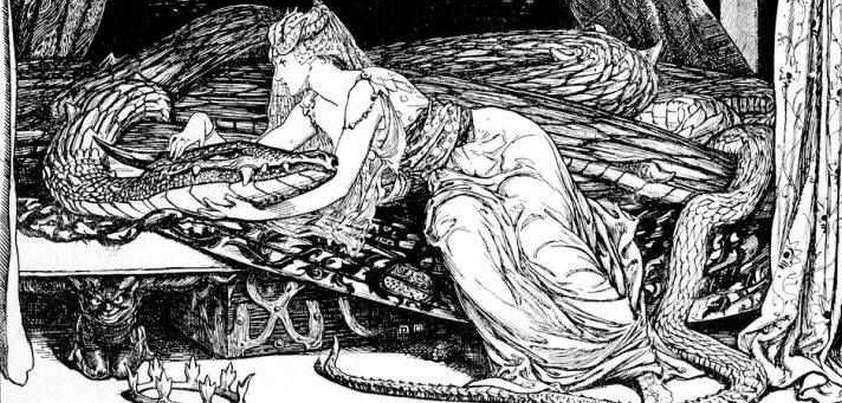 In this Serbian folktale, a young girl stops her rich but cruel father from setting his dogs on three old men who come begging to his door. The old men are not really beggars, but fairies. They foretell that a baby boy in a nearby village will one day own all the rich man’s money and land. The rich man learns this and tries several times to kill the boy. However, he boy survives and the fairies’ prophesy comes true. As a final punishment, the rich man must work forever in a job that is much worse than begging. More…
In this Serbian folktale, a young girl stops her rich but cruel father from setting his dogs on three old men who come begging to his door. The old men are not really beggars, but fairies. They foretell that a baby boy in a nearby village will one day own all the rich man’s money and land. The rich man learns this and tries several times to kill the boy. However, he boy survives and the fairies’ prophesy comes true. As a final punishment, the rich man must work forever in a job that is much worse than begging. More…
The Golden Goose
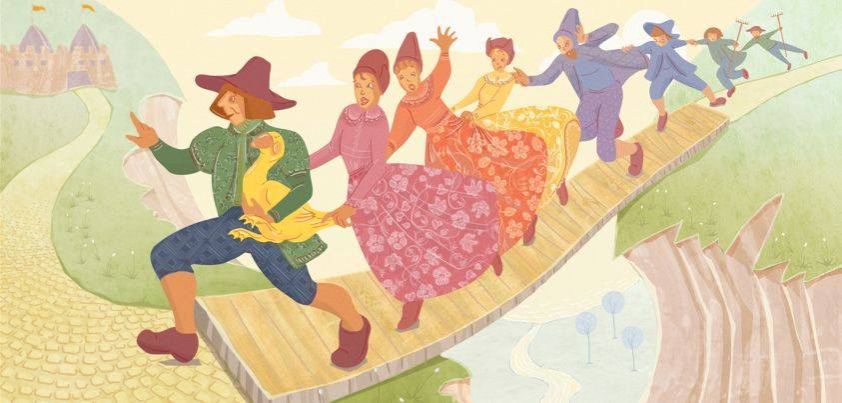 The Golden Goose is about a kind but not very clever young man who one day shares his food with a hungry old man. The old man tells him where to find a goose that has feathers of gold. The goose has a strange power. Those who touch it, and any who touch them, cannot remove their hands. A king, who has a daughter that has never laughed, has promised that she will marry the first man to make do so. The man and goose, with seven people running behind stuck fast to them, look silly enough to do this. More…
The Golden Goose is about a kind but not very clever young man who one day shares his food with a hungry old man. The old man tells him where to find a goose that has feathers of gold. The goose has a strange power. Those who touch it, and any who touch them, cannot remove their hands. A king, who has a daughter that has never laughed, has promised that she will marry the first man to make do so. The man and goose, with seven people running behind stuck fast to them, look silly enough to do this. More…
Tom Tit Tot / Rumpelstiltskin
 The protagonist in Tom Tit Tot is a lazy girl who doesn’t appear to be good at anything except eating. Her mother lies to the king by saying she is a whiz with the spinning wheel. For some reason this is just the kind of girl the king is looking to marry. The poor girl can’t even spin a top, so in order to avoid losing her head she accepts an offer of help from a small magical creature. As the creature helps the girl, she must try to guess its name. If she can’t, she shall become “its”. More…
The protagonist in Tom Tit Tot is a lazy girl who doesn’t appear to be good at anything except eating. Her mother lies to the king by saying she is a whiz with the spinning wheel. For some reason this is just the kind of girl the king is looking to marry. The poor girl can’t even spin a top, so in order to avoid losing her head she accepts an offer of help from a small magical creature. As the creature helps the girl, she must try to guess its name. If she can’t, she shall become “its”. More…
Brother and Sister
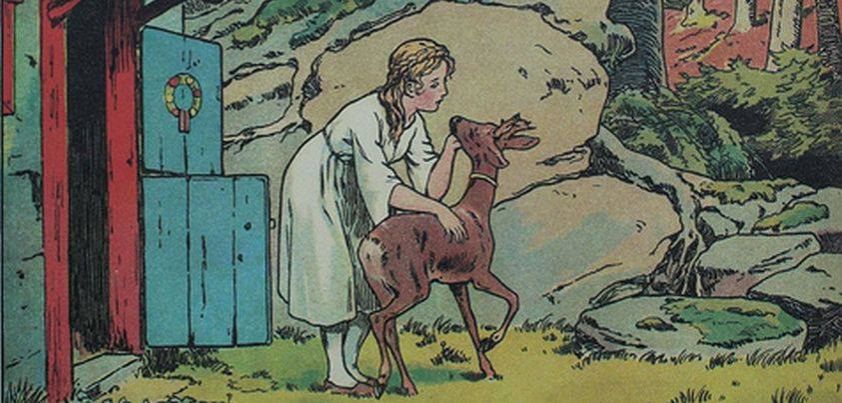 This is a well-known European folktale. A brother and sister run away from home after years of being badly treated by (you guessed it!) their wicked stepmother. The stepmother also happens to be a witch, and the children have some unlikely adventures. The brother is turned into a deer that loves nothing better than to be hunted. The sister becomes a Queen, has a baby, and is murdered by (you guessed it!) the wicked stepmother. Fortunately, the sister’s ghost comes back to life, the brother is made normal again, and they all (except the wicked stepmother) live happily ever after. More…
This is a well-known European folktale. A brother and sister run away from home after years of being badly treated by (you guessed it!) their wicked stepmother. The stepmother also happens to be a witch, and the children have some unlikely adventures. The brother is turned into a deer that loves nothing better than to be hunted. The sister becomes a Queen, has a baby, and is murdered by (you guessed it!) the wicked stepmother. Fortunately, the sister’s ghost comes back to life, the brother is made normal again, and they all (except the wicked stepmother) live happily ever after. More…
The Twelve Months
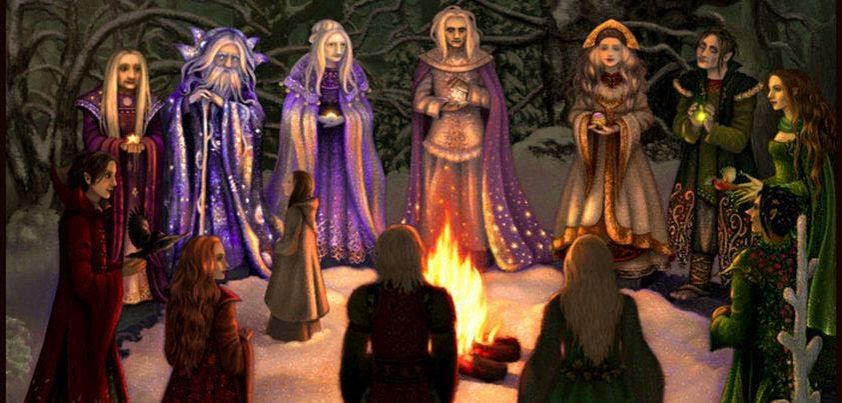 Although this folktale has been called the “Slavic Cinderella”, for me it doesn’t quite get there. We have a young girl persecuted by family and a magical element (the gods of the twelve months of the year) that helps her, but here the comparison ends. There is no ball or special event, no beautiful clothes, and no handsome prince. She falls in love with a kind man and the two spend a blissful life of drudgery taking care of her family farm. As nice as it seems, this is not what most people would call a ‘fairytale’ ending! More…
Although this folktale has been called the “Slavic Cinderella”, for me it doesn’t quite get there. We have a young girl persecuted by family and a magical element (the gods of the twelve months of the year) that helps her, but here the comparison ends. There is no ball or special event, no beautiful clothes, and no handsome prince. She falls in love with a kind man and the two spend a blissful life of drudgery taking care of her family farm. As nice as it seems, this is not what most people would call a ‘fairytale’ ending! More…
The Golden Nugget
 This Chinese folktale tells of two friends who would do anything for each other. One day they decide to go for a walk in a forest. During the walk, the friends see a gold nugget on the path. Unable to decide who should have it, they leave it where it is so as not to cause trouble between them. They later tell a greedy farmer about the nugget. He goes to get it, and becomes angry when he finds something unpleasant in its place. The two friends go back to look, and are well rewarded for their trouble. More…
This Chinese folktale tells of two friends who would do anything for each other. One day they decide to go for a walk in a forest. During the walk, the friends see a gold nugget on the path. Unable to decide who should have it, they leave it where it is so as not to cause trouble between them. They later tell a greedy farmer about the nugget. He goes to get it, and becomes angry when he finds something unpleasant in its place. The two friends go back to look, and are well rewarded for their trouble. More…
The Fish and the Ring
 In this Scottish folktale, a rich and powerful man looks into the future and learns that the fate of his son is to marry a girl from a very poor family. He wants a high society wife for his son and does everything that he can to stop the marriage. He unsuccessfully tries to kill the poor girl twice, and is about to throw her over a cliff when she agrees to go away forever. A hungry fish brings them together again and teaches him that, no matter how much you try, you can’t change what is meant to be. More…
In this Scottish folktale, a rich and powerful man looks into the future and learns that the fate of his son is to marry a girl from a very poor family. He wants a high society wife for his son and does everything that he can to stop the marriage. He unsuccessfully tries to kill the poor girl twice, and is about to throw her over a cliff when she agrees to go away forever. A hungry fish brings them together again and teaches him that, no matter how much you try, you can’t change what is meant to be. More…
Toads and Diamonds (The Fairies)
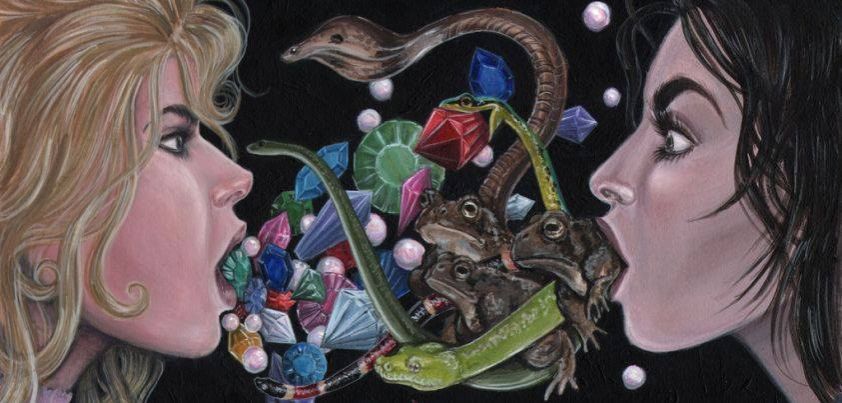 This story from Charles Perrault is about a bad-tempered, greedy widow and her two daughters. One girl is selfish, rude and ugly but loved by her mother. The other girl is kind, polite and beautiful but treated badly. With the help of a fairy (who else?), the kind daughter marries a prince and the selfish daughter dies alone. The story leaves readers wondering about the fairy’s gift. Life would be miserable (and maybe impossible) if something fell from your mouth every time you opened it? Also, did the prince really marry her out of love, or was it for diamonds? More…
This story from Charles Perrault is about a bad-tempered, greedy widow and her two daughters. One girl is selfish, rude and ugly but loved by her mother. The other girl is kind, polite and beautiful but treated badly. With the help of a fairy (who else?), the kind daughter marries a prince and the selfish daughter dies alone. The story leaves readers wondering about the fairy’s gift. Life would be miserable (and maybe impossible) if something fell from your mouth every time you opened it? Also, did the prince really marry her out of love, or was it for diamonds? More…
The Stonecutter
 This folktale from Japan is about a hardworking man who leads a poor but happy life until the day a mountain spirit decides to grant him several wishes. Predictably, his initial wish is for riches. When this does not satisfy, he craves power. He starts with power over man (as a prince), and moves on to power over nature (as the sun, a cloud, and a great rock on a mountainside). He is never satisfied until finally realizing that a humble stonecutter has as much power as anyone or anything on Earth. More…
This folktale from Japan is about a hardworking man who leads a poor but happy life until the day a mountain spirit decides to grant him several wishes. Predictably, his initial wish is for riches. When this does not satisfy, he craves power. He starts with power over man (as a prince), and moves on to power over nature (as the sun, a cloud, and a great rock on a mountainside). He is never satisfied until finally realizing that a humble stonecutter has as much power as anyone or anything on Earth. More…
The False Prince and True
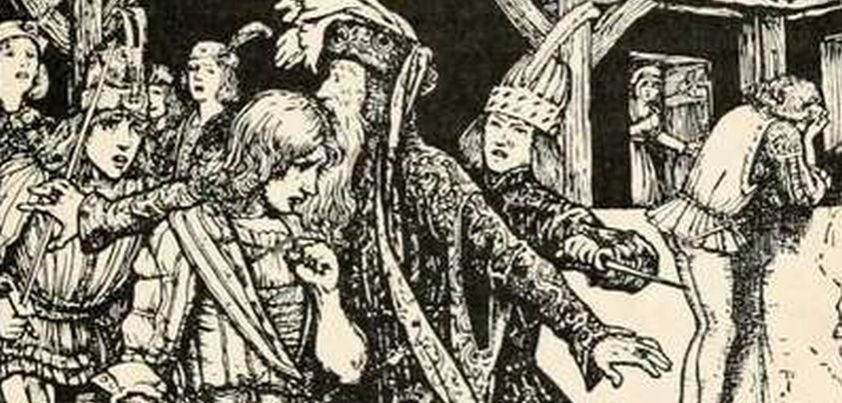 This Portuguese folktale begins with a king learning about an argument between his son and a young nobleman on a tennis court. The prince spoke rudely to the noble, who lost his temper and hit him. Although the king is angrier with his son for not fighting back than the noble, hitting the prince is punishable by death. The only way the noble can save himself is to marry a very ugly, very old woman. As is often the case in folktales, there is a lot of magic around and some surprises are on the way for all involved. More…
This Portuguese folktale begins with a king learning about an argument between his son and a young nobleman on a tennis court. The prince spoke rudely to the noble, who lost his temper and hit him. Although the king is angrier with his son for not fighting back than the noble, hitting the prince is punishable by death. The only way the noble can save himself is to marry a very ugly, very old woman. As is often the case in folktales, there is a lot of magic around and some surprises are on the way for all involved. More…
The Ass, the Table, and the Stick
 In this English folktale, a young man works for a year and earns a magic donkey. An innkeeper tricks him out of it, so he works for another year and earns a magic table. The same innkeeper tricks him out of this. For his next job, the boy earns a magic stick. This helps the young man get his donkey and table back, as well as to marry his true love. Unfortunately, in winning the girl the young man shows a side of his personality that will make readers wonder if he really deserved all the magical help! More…
In this English folktale, a young man works for a year and earns a magic donkey. An innkeeper tricks him out of it, so he works for another year and earns a magic table. The same innkeeper tricks him out of this. For his next job, the boy earns a magic stick. This helps the young man get his donkey and table back, as well as to marry his true love. Unfortunately, in winning the girl the young man shows a side of his personality that will make readers wonder if he really deserved all the magical help! More…
Tam and Cam
 As indicated in our comments on the famous children’s story Cinderella, there are hundreds of folktales around the world that have the similar central plots. This Vietnamese version is longer and continues after the protagonist becomes Queen. The story from here on could only happen in a folktale from a country where people believe that after we die we can be born again in non-human form. The poor girl is killed twice after marrying the king, each time coming back to life in a different form. Fortunately, goodness wins out and the evil stepsister soon finds herself in hot water. More…
As indicated in our comments on the famous children’s story Cinderella, there are hundreds of folktales around the world that have the similar central plots. This Vietnamese version is longer and continues after the protagonist becomes Queen. The story from here on could only happen in a folktale from a country where people believe that after we die we can be born again in non-human form. The poor girl is killed twice after marrying the king, each time coming back to life in a different form. Fortunately, goodness wins out and the evil stepsister soon finds herself in hot water. More…
Christmas Every Day
 This children’s story by W. D. Howells is actually a ‘story within a story’. A demanding daughter insists that her busy father tell her a Christmas story. Perhaps with his daughter in mind, he makes up a tale about a little girl who makes a selfish Christmas wish. She wants it to be Christmas every day so she can get presents and eat Christmas treats all year long. The wish comes true but in so doing causes problems for almost everyone in the world. Although told in an amusing way, you could call this a Christmas horror fairy-tale. More…
This children’s story by W. D. Howells is actually a ‘story within a story’. A demanding daughter insists that her busy father tell her a Christmas story. Perhaps with his daughter in mind, he makes up a tale about a little girl who makes a selfish Christmas wish. She wants it to be Christmas every day so she can get presents and eat Christmas treats all year long. The wish comes true but in so doing causes problems for almost everyone in the world. Although told in an amusing way, you could call this a Christmas horror fairy-tale. More…
The Water of Life
 The major themes of this fairy-tale by Howard Pyle are that money and status don’t necessarily reflect the inner man, and loyalty can sometimes bring great rewards. A princess vows to marry whoever brings her a cup of water from the “Fountain of Life”. A young king sends a servant on the long and dangerous journey to collect some, and falsely claims the prize. The doubtful princess sets him two more tasks, one of which requires cutting off the faithful servant’s hand. Thanks to the Water of Life, things end happily for the servant but not so for the king. More…
The major themes of this fairy-tale by Howard Pyle are that money and status don’t necessarily reflect the inner man, and loyalty can sometimes bring great rewards. A princess vows to marry whoever brings her a cup of water from the “Fountain of Life”. A young king sends a servant on the long and dangerous journey to collect some, and falsely claims the prize. The doubtful princess sets him two more tasks, one of which requires cutting off the faithful servant’s hand. Thanks to the Water of Life, things end happily for the servant but not so for the king. More…
The Frog
 Most ‘frog’ folktales involve a frog prince or at the very least a male frog. However, in this story from Italy, a female frog makes friends with a young man and helps him keep his mother happy as he searches for a wife. Little does the young man know that his perfect woman is sitting on a rock beside him. Three possible morals: 1) Sometimes we don’t appreciate those around us enough; 2) Often the thing we are looking for is right under our noses; 3) Or how about the English idiom beauty is only (frog) skin deep. More…
Most ‘frog’ folktales involve a frog prince or at the very least a male frog. However, in this story from Italy, a female frog makes friends with a young man and helps him keep his mother happy as he searches for a wife. Little does the young man know that his perfect woman is sitting on a rock beside him. Three possible morals: 1) Sometimes we don’t appreciate those around us enough; 2) Often the thing we are looking for is right under our noses; 3) Or how about the English idiom beauty is only (frog) skin deep. More…
The Fisherman and His Wife
 It’s time for another folktale. This one is about dissatisfaction and greed. A poor fisherman catches an enchanted fish and sets it free. When he tells his wife, she is angry that he did not demand a wish in return. She sends him to ask the fish for a nicer house. When the fish grants this, the wife becomes greedy. She sends her husband back several times to ask for bigger and bigger things. Her final wish is so outrageous that the fish either will not or cannot grant it. The fisherman is no doubt happy with what happens next. More…
It’s time for another folktale. This one is about dissatisfaction and greed. A poor fisherman catches an enchanted fish and sets it free. When he tells his wife, she is angry that he did not demand a wish in return. She sends him to ask the fish for a nicer house. When the fish grants this, the wife becomes greedy. She sends her husband back several times to ask for bigger and bigger things. Her final wish is so outrageous that the fish either will not or cannot grant it. The fisherman is no doubt happy with what happens next. More…